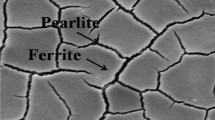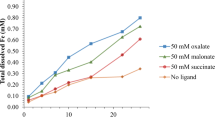Abstract
Synthetic iron oxides (goethite, α-FeO·OH; hematite, Fe2O3; and ferrihydrite, Fe(OH)3) were used as model compounds to simulate the mineralogy of surface films on carbon steel. Dissolution of these oxides exposed to pure cultures of the metal-reducing bacterium, Shewanella putrefaciens, was followed by direct atomic absorption spectroscopy measurement of ferrous iron coupled with microscopic analyses using confocal laser scanning and environmental scanning electron microscopies. During an 8-day exposure the organism colonized mineral surfaces and reduced solid ferric oxides to soluble ferrous ions. Elemental composition, as monitored by energy dispersive x-ray spectroscopy, indicated mineral replacement reactions with both ferrihydrite and goethite as iron reduction occurred. When carbon steel electrodes were exposed to S. putrefaciens, microbiologically influenced corrosion was demonstrated electrochemically and microscopically.
Similar content being viewed by others
References
American Petroleum Institute (1965) API recommended practice for biological analysis of subsurface injection waters, NY, NY
Arnold RG, DiChristina T & Hoffmann M (1988) Reductive dissolution of Fe(III) oxides by Pseudomonas sp. 200. Biotechnol. Bioeng. 32: 1081- 1096
Boivin J, Laishley EJ, Bryant RD & Costerton JW (1990) The influence of enzyme systems on MIC, CORROSION/90, paper no. 128, NACE International, Houston, TX
Ehrlich HL (1996) How microbes influence mineral growth and dissolution. Chem. Geol. 132: 5- 9
Hersman L, Maurice P & Sposito G (1996) Iron acquisition from hydrous Fe(III)-oxides by an aerobic Pseudomonas sp.. Chem. Geol. 132: 25- 31
Little B, Wagner P & Mansfeld F (1991a) Microbiologically influenced corrosion of metals and alloys. Int. Mat. Rev. 36, 6: 253- 272
Little B, Wagner P, Ray R, Pope R & Scheetz R (1991b) Biofilms: an ESEM evaluation of artifacts introduced during SEM preparation. J. Industr. Microbiol. 8: 213- 222
Lovley DR & Woodward JC (1996) Mechanisms for chelator stimulation of microbial Fe(III)-oxide reduction. Chem. Geol. 132: 19- 24
Mansfeld F & Little B (1992) Electrochemical techniques applied to studies of microbiologically influenced corrosion (MIC). Trends in Electrochemistry 1: 47- 61
McDonnell MT & Colwell RR (1985) Phylogeny of the Vibrionaceae, and recommendation for two new genera, Listonella and Shewanella. Syst. Appl. Microbiol. 6: 171- 182
McNeil MB, Jones JM & Little BJ (1991) Mineralogical fingerprints for corrosion processes induced by sulfate-reducing bacteria. CORROSION/91, paper no. 580, NACE International, Houston, TX
McNeil MB & Little BJ (1990) Mackinawite formation during microbial corrosion. Corrosion 46(7): 599- 600
Myers C & Nealson K (1988) Bacterial manganese reduction and growth with manganese oxide as the sole electron acceptor. Science 240: 1319- 1321
Nealson KH & Saffarini DA (1994) Iron andmanganese in anaerobic respiration. Ann. Rev. Microbiol. 48: 311- 343
Obuekwe CO, Westlake DWS, Plambeck JA & Cook FD (1981) Corrosion of mild steel in cultures of ferric iron reducing bacterium isolated from crude oil I. polarization characteristics. Corrosion 37, 8: 461- 467
Pope DH, Duquette DJ, Wayner Jr. PC & Johannes AH (1984) Microbiologically influenced corrosion: a state of the art review, Materials Technology Institute of the Chemical Process Industries, Columbus, OH
Semple K & Westlake D (1987) Characterization of iron reducing Alteromonas putrefaciens strains from oil field fluids. Can. J. Microbiol. 33: 366- 371
Stelzer EHK, Wacker I & DeMey JR (1991) Confocal fluorescence microscopy in modern cell biology. Cell Biology 2: 145- 152
Szklarska-Smialowska Z (1986) Pitting Corrosion of Metals. NACE International, Houston, TX
Tatnall RE, Stanton KM & Ebersole RC (1988) Methods of testing for the presence of sulfatereducing bacteria, CORROSION/88, paper no. 88, NACE International, Houston, TX
Wagner P & Little B (1986) Applications of a technique for the investigation of microbially induced corrosion. CORROSION/86, paper no. 121, NACE International, Houston, TX
Rights and permissions
About this article
Cite this article
Little, B., Wagner, P., Hart, K. et al. The role of biomineralization in microbiologically influenced corrosion. Biodegradation 9, 1–10 (1998). https://doi.org/10.1023/A:1008264313065
Issue Date:
DOI: https://doi.org/10.1023/A:1008264313065




